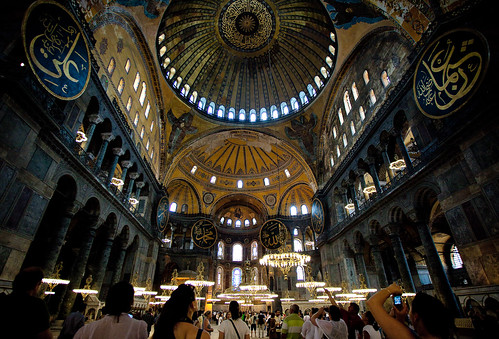Istanbul is one of the world’s great metropolises. The city reflects the cultural influences of different empires that once ruled it, including those of the Greeks, Persians, Romans, and Venetians. Remnants of this varied history are scattered throughout the city. Here are five sites you won’t want to miss on your visit.
Aya Sofya

Image via Flickr by eleephotography
Formerly the Hagia Sophia, the Aya Sofya was Byzantine Emperor Justinian’s church in 536 A.D. It was the emperor’s statement to the world of his empire’s wealth and technological advancement. Tradition states that the area inside the church that surrounded the emperor’s throne was the official center of the world.
Aya Sofya got converted into a mosque after the Ottoman armies conquered Constantinople and became a museum in the 20th century. It has remained one of Istanbul’s most cherished landmarks.
Topkapi Palace
This vast complex housed sultans of the Ottoman empire up until the 19th century and is now a dazzling display of Islamic art. Topkapi Palace has lavish courtyards lined with elaborate, hand-painted tile work linking several luxuriously decorated rooms, and battlement walls and towers surround it all. Plan on spending half a day touring this glorious palace. The nearby four-star Maywood Hotel will keep your day simple.
Blue Mosque
Sultan Ahmet I’s grand architectural gift to his capital was the Blue Mosque. Built between 1609 and 1616, the mosque caused an uproar throughout the Muslim world because it had the same number of minarets as the Great Mosque of Mecca. Eventually, Mecca received another minaret as a gift to ease the conflict.
The Blue Mosque’s nickname comes from its interior, which features thousands of Iznik tiles. The spatial and color effects make the Blue Mosque one of the finest achievements of Ottoman architecture.
Basilica Cistern
The Basilica Cistern once stored the imperial water supply for Byzantine emperors. The Basilica is very serene with its lit columns and softly trickling water. 336 columns arranged in 12 rows support the palace-like underground hall. The builders of the cistern recycled many of the decoratively carved columns from earlier classical structures. The most famous columns are the ones known as the Medusa stones. Located in the northwest corner, these columns have Medusa head carvings at their bases.
Hippodrome
The Hippodrome was the center of Byzantine public life. It was the location of games, chariot races, and factional conflicts. Only a small section of gallery walls is left of the Hippodrome. Today, the At Meydani park stands on the site and is home to a variety of monuments.
A fountain is on the northwest side of the Hippodrome. German Emperor William II presented the fountain to the Ottoman sultan in 1898. Three ancient monuments stand on the southwest side: the Egyptian obelisk from Heliopolis; the Serpent Column brought from Delphi by Constantine; and a stone obelisk. Gold-colored bronze plating originally covered the stone obelisk, but soldiers of the 4th Crusade stole the plating in 1204.
These five landmarks show off Istanbul’s vast history and culture perfectly. Be sure to add them to your itinerary.

No comments:
Post a Comment